|
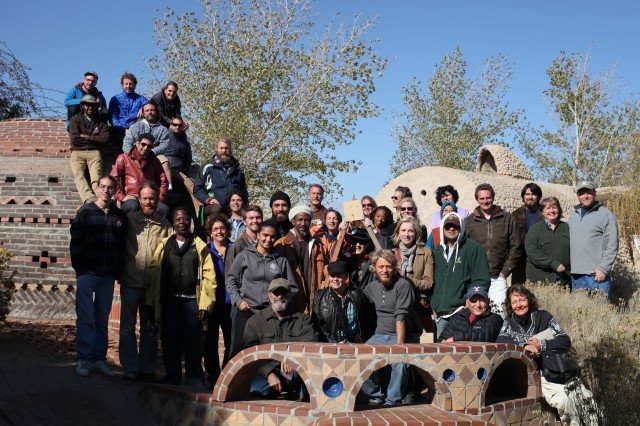
We not only taught this course to 24 students from around the world (Europe, Middle East, Africa) but we also trained 7 of Cal-Earth’s staff. and 2 of their interns. Nader Khalili was just months away from hosting the first PDC course at Cal-Earth when he unexpectedly passed in 2008. To honor their father and the 20th anniversary of Cal-Earth, Dastan and Sheefteh Khalili, Nader’s children, invited us to deliver our PDC course. As Ian Lodge (director at Cal-Earth) told us , “the hard work of proving the viability of superadobe structures is done. It’s now time to look at the total environment, to see how much better the buildings and the land around them can function together to benefit the people living in them.”
|
|
|
 The key instructors for this training were (from right) myself, Becky and Wayne Weiseman. We also invited in local permaculturists Wes Roe and Margie Bushman of the Santa Barbara Permaculture Network. They taught for a half-day on the importance of good networking and the building of human relationships in within community. Margie and Wes were good friends of Nader’s and are the permaculture glue in Southern California. The key instructors for this training were (from right) myself, Becky and Wayne Weiseman. We also invited in local permaculturists Wes Roe and Margie Bushman of the Santa Barbara Permaculture Network. They taught for a half-day on the importance of good networking and the building of human relationships in within community. Margie and Wes were good friends of Nader’s and are the permaculture glue in Southern California.
We are standing in front of “Earth One” which was designed as a more conventional home but still made from superadobe. It became the classroom for our course.
|
| |
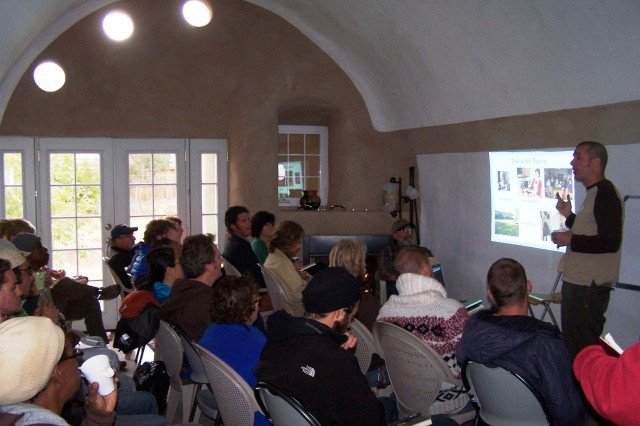 Our own IT guru and permaculture teacher, Milton Dixon, kicked off our training with a presentation on urban permaculture. Since he lives in the heart of Chicago, and many of our students also live in a highly urban environments, we felt it was important to show the contrast to rural living and how to incorporate a permaculture approach to living in the city. Our own IT guru and permaculture teacher, Milton Dixon, kicked off our training with a presentation on urban permaculture. Since he lives in the heart of Chicago, and many of our students also live in a highly urban environments, we felt it was important to show the contrast to rural living and how to incorporate a permaculture approach to living in the city. |
| |
 Even our son, Hayden, cut his ‘permaculture teaching teeth’ during this training, sharing how we have incorporated permaculture design into our own suburban yard in Illinois. Even our son, Hayden, cut his ‘permaculture teaching teeth’ during this training, sharing how we have incorporated permaculture design into our own suburban yard in Illinois.
It’s the first time we have ever projected our teaching aids on to an adobe wall. |
| |
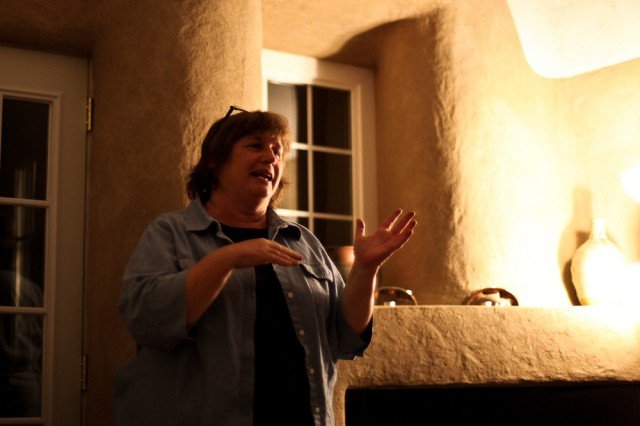 Becky lends a holistic and wise perspective to the permaculture design process. It was such a pleasure for all of us to teach in such a wonderful setting. Becky lends a holistic and wise perspective to the permaculture design process. It was such a pleasure for all of us to teach in such a wonderful setting. |
| |
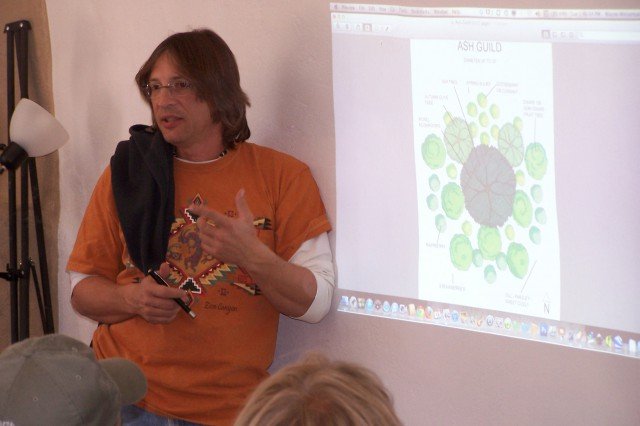 Besides the delivery of a large body of permaculture information, much of the training is designed to pull the knowledge out of the student. Here, one of Cal-Earth’s staff, Erik, brainstorms with other students what the make-up of an ash tree guild might be. Besides the delivery of a large body of permaculture information, much of the training is designed to pull the knowledge out of the student. Here, one of Cal-Earth’s staff, Erik, brainstorms with other students what the make-up of an ash tree guild might be. |
| |
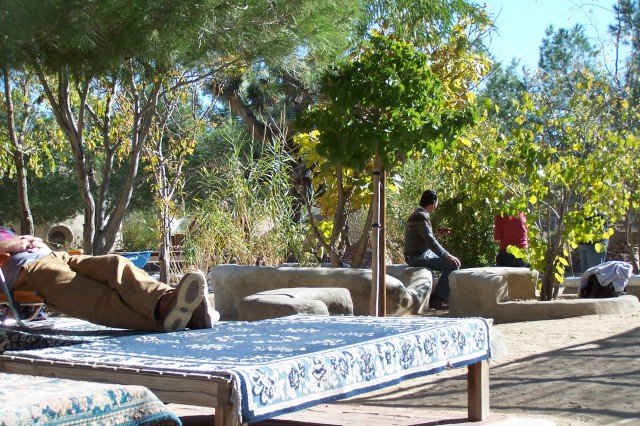 Better weather the second week lent itself to sun bathing during our breaks. Better weather the second week lent itself to sun bathing during our breaks. |
| |
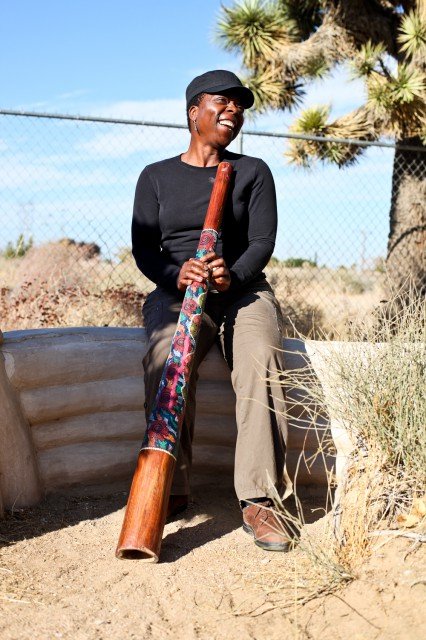 Although we had very full days, students made the most out of their time off by relaxing and visiting with one another. Here a student from Liberia, Africa, was treated to a quick lesson on how to play the Australian didgeridoo. Although we had very full days, students made the most out of their time off by relaxing and visiting with one another. Here a student from Liberia, Africa, was treated to a quick lesson on how to play the Australian didgeridoo. |
| |
 Back to the training… I used a clay model to mimic a landscape so we could demonstrate how to incorporate swales, ponds and keylines as methods to hold water on the landscape. Back to the training… I used a clay model to mimic a landscape so we could demonstrate how to incorporate swales, ponds and keylines as methods to hold water on the landscape.
“The clay model brought the whole subject of holding water on the landscape
to clarity for me.”
Student |
| |
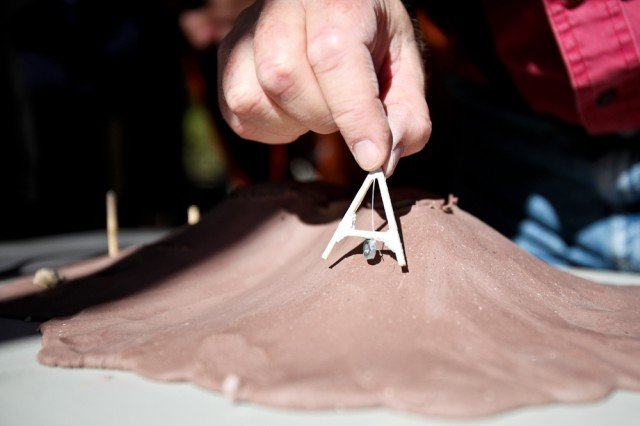 Demonstrating the use of an A-frame on the clay model. Demonstrating the use of an A-frame on the clay model. |
| |
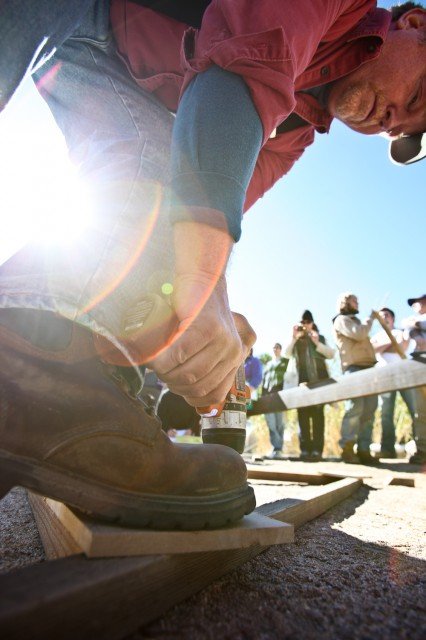 After the demonstration comes the building and using of the A-frame. We built one in less than 5 minutes and then taught students how to use it to find contours. After the demonstration comes the building and using of the A-frame. We built one in less than 5 minutes and then taught students how to use it to find contours. |
| |
 I explain on the site where we were going to dig a swale, how to combine a swale with a hugelkultur bed. I explain on the site where we were going to dig a swale, how to combine a swale with a hugelkultur bed. |
| |
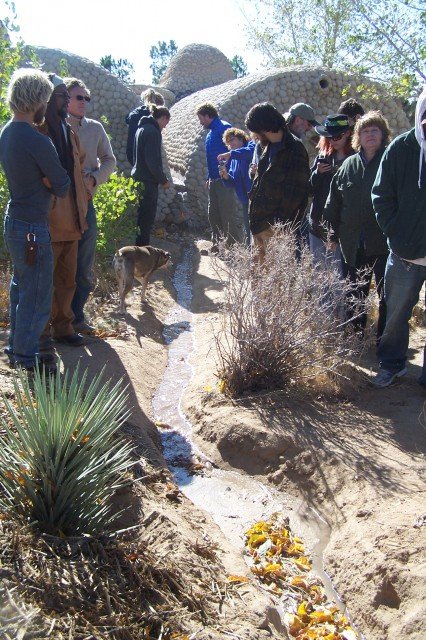 After finding the contour, our students dug a swale and attached hugelkultur bed. After completed, we turned on a hose so everyone could see how the water flowed and the system worked. The water flowed into the hugelkultur bed where massive amounts of wood can now hold the water for longer periods of time to support plant life and minimize the need for regular watering in this desert environment. After finding the contour, our students dug a swale and attached hugelkultur bed. After completed, we turned on a hose so everyone could see how the water flowed and the system worked. The water flowed into the hugelkultur bed where massive amounts of wood can now hold the water for longer periods of time to support plant life and minimize the need for regular watering in this desert environment. |
| |
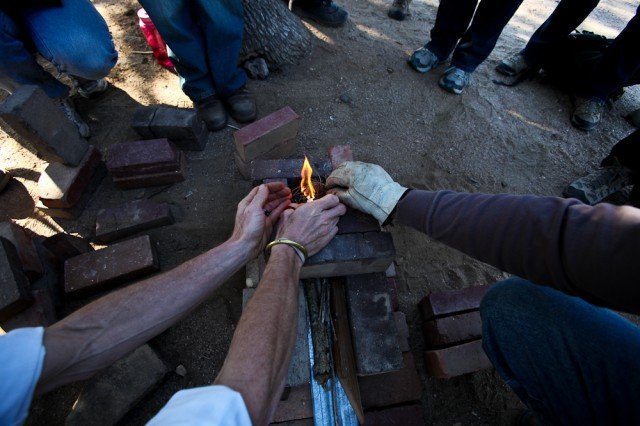 Demonstrating how to build and fire-up a rocket stove turned out to be a very interesting project for students. We just built a demonstration model, but a thermal mass rocket stove would be a perfect addition to any of the superadobe structures for heating and cooking in the winter months. Demonstrating how to build and fire-up a rocket stove turned out to be a very interesting project for students. We just built a demonstration model, but a thermal mass rocket stove would be a perfect addition to any of the superadobe structures for heating and cooking in the winter months. |
| |
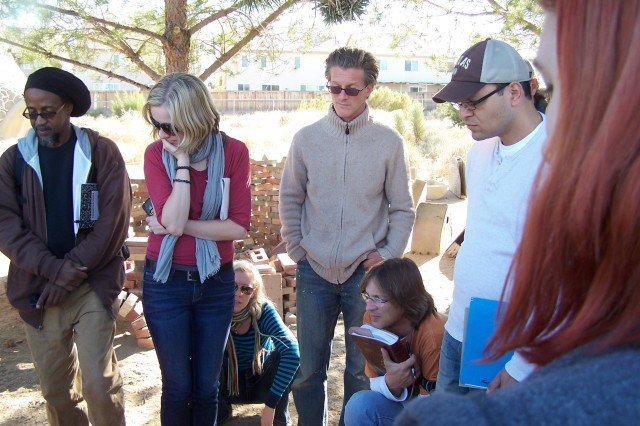 Many had heard of the concept but few hand ever seen one built and in operation. Many had heard of the concept but few hand ever seen one built and in operation. |
| |
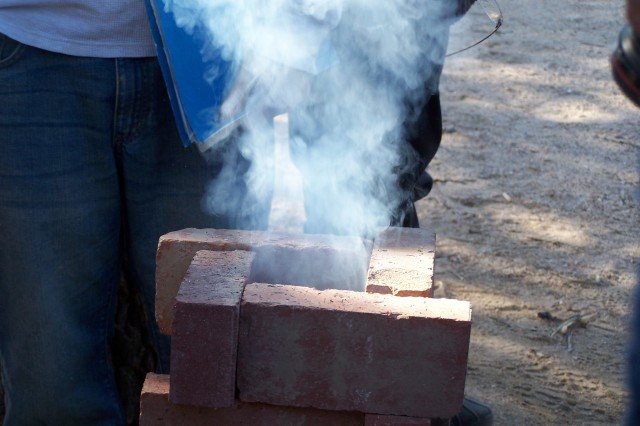 The ‘stack’ or chimney of the stove is about 3 foot tall and in this case, made from bricks. When first lit, the stove smokes about as much as a typical wood fire. The ‘stack’ or chimney of the stove is about 3 foot tall and in this case, made from bricks. When first lit, the stove smokes about as much as a typical wood fire. |
| |
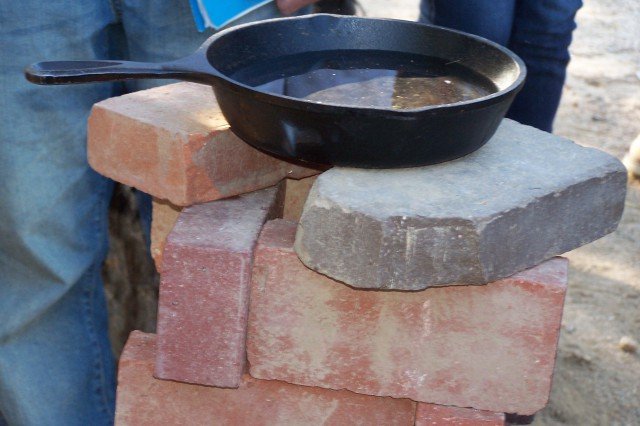 However, once the stove really starts to burn and begins to make the ‘rocket’ sound, the smoke clears away and a tremendous amount of clean heat shoots from the stack. This stove is in full burn mode as the photo is taken. A skillet of water this size will boil in less than 5 minutes with just a small handful of wood if the firing is done correctly. However, once the stove really starts to burn and begins to make the ‘rocket’ sound, the smoke clears away and a tremendous amount of clean heat shoots from the stack. This stove is in full burn mode as the photo is taken. A skillet of water this size will boil in less than 5 minutes with just a small handful of wood if the firing is done correctly. |
| |
|
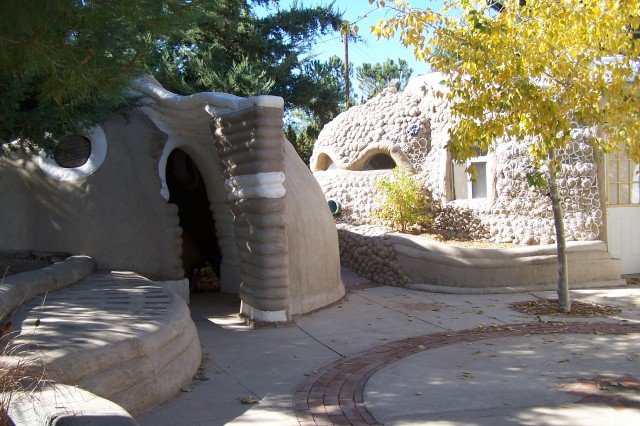 Student housing on site was available for free in what Cal-Earth calls their UN emergency housing village. Any of these small shelters can be made in just a few days with a handful of people. Student housing on site was available for free in what Cal-Earth calls their UN emergency housing village. Any of these small shelters can be made in just a few days with a handful of people.
|
| |
 Here is a student enjoying his lunch break. Here is a student enjoying his lunch break. |
| |
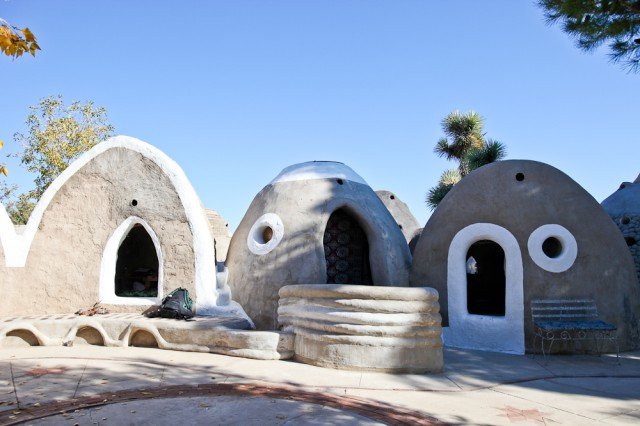 Moon shelters? Because of the basic elements involved to build these domes, Nader did research for NASA and was able to demonstrate the feasibility of building superadobe structures on the moon. Since the material used to build a structure is right below one’s feet, the cost to ship building supplies into space was dramatically minimized. Moon shelters? Because of the basic elements involved to build these domes, Nader did research for NASA and was able to demonstrate the feasibility of building superadobe structures on the moon. Since the material used to build a structure is right below one’s feet, the cost to ship building supplies into space was dramatically minimized. |
| |
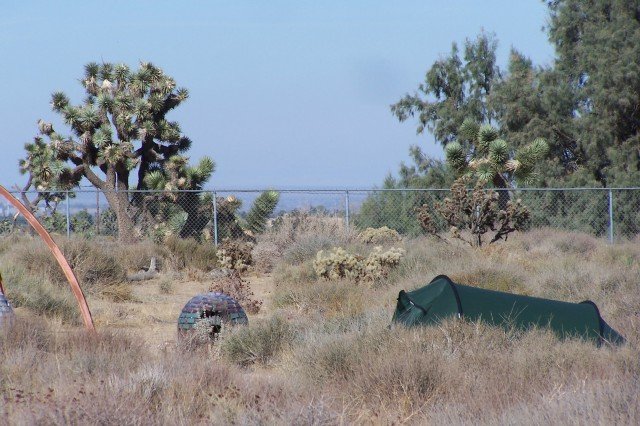 One of our students (a man from Sweden) decided to set up his own tent. One of our students (a man from Sweden) decided to set up his own tent. |
| |

Near the end of the training, students began working on their final design project. As a group, they developed a full site plan that had an emphasis on how to harvest and hold water. The goal is to turn the Cai-Earth site into a desert oasis. |
| |
 They broke up into 4 teams and created an integrated design together. They did a great job. They broke up into 4 teams and created an integrated design together. They did a great job. |
| |
|
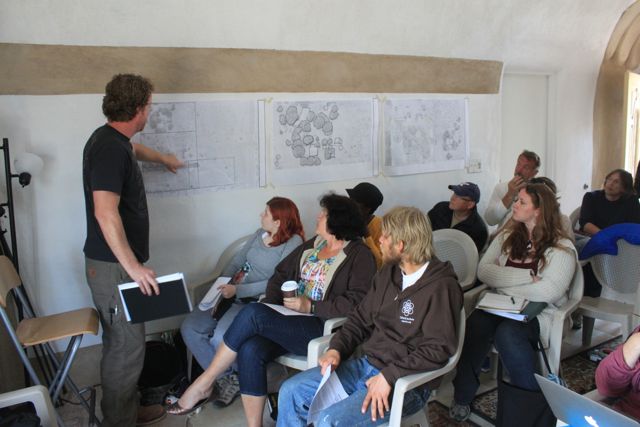
On their last day, students pulled together their design work and made a full presentation to Nader Khalili’s daughter, Sheefteh, of their work.
|
|
 Sheefteh gives much of her time to the Cal-Earth not-for-profit organization while maintaining a very full schedule of her own, working on her PhD dissertation. We found her to be as devoted and inspiring as her father. Sheefteh gives much of her time to the Cal-Earth not-for-profit organization while maintaining a very full schedule of her own, working on her PhD dissertation. We found her to be as devoted and inspiring as her father. |
| |
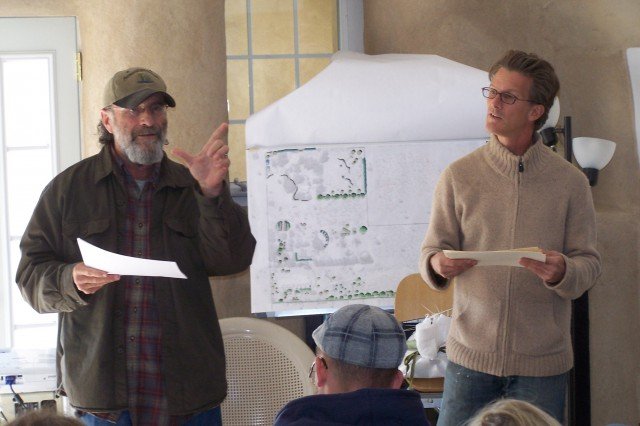 The training ended with the awarding of our “Certificates of Completion” to students, from both The training ended with the awarding of our “Certificates of Completion” to students, from both
Midwest Permaculture and Cal-Earth. |
| |
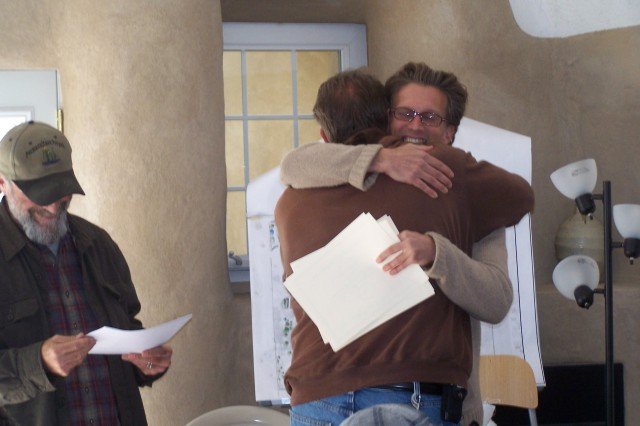 Our long time friend and fellow teacher, Wayne Weiseman, did the honors for us while Our long time friend and fellow teacher, Wayne Weiseman, did the honors for us while
Ian Lodge awarded the Cal-Earth certificates. |
| |
|
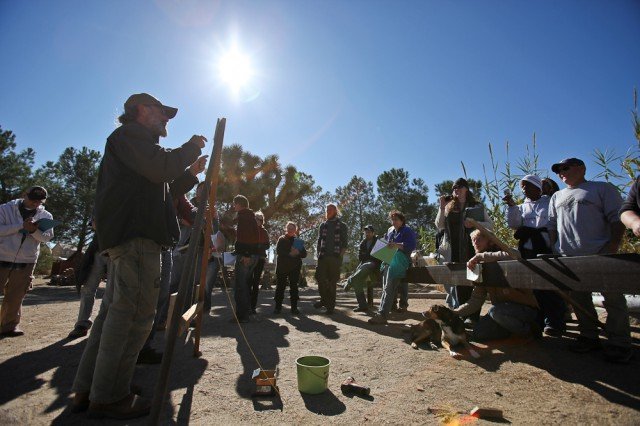
The plans at Cal-Earth are to begin to implement our overall permaculture design to the landscape, taking it a step at a time. May this be the first of many trainings in the coming decades for Cal-Earth and Midwest Permaculture as we support their endeavors.
|
|
|
|
For Becky and me, this training is an example of the amazing gifts that we receive by working in the area of permaculture. Where else does one find such wonderful and inspiring people to work with?
We want to thank Dastan and Sheefteh Khalili, Ian Lodge, and the entire staff at Cal-Earth. We are grateful for this opportunity to work with you all.
To our viewers, Please keep an eye on our schedule for future PDC courses.
We’d love to have you join us if this training looked like a wonderful experience to you too.
|
| Great Regards… Bill Wilson (Nov. 2011) |
| |
8 thoughts on “Cal-Earth – The PDC Portion of the Combined Earth Building and Permaculture Training”
This looked FABULOUSSSSS! I was there in spirit just so you know!
HI
your presentation was most helpful. I have considered this course as i think it just makes sense. I was a philosophy student years ago and often wandered how much better it would be to show people how to build economically and responsibly.
i have 2 questions.
It appears that this process is greatly expedited by using a concrete pump. Do you have any idea on the specs of the pump so i can get a rough idea of the cost.
And what advise would you have for introducing this concept and getting a building permit in northern climates–that is in the mountains surrounded by pine? Is there a component of the code that applies to these structures or is it on a case by case basis?
thanks Dan
Hi Dan,
We did not use a concrete pump in any of the building we did. At most the mixtures we made contained 10% concrete and we used a small mixer to make the batches.
As for the building permits, I know that they have obtained building permits but I don’t know the details. I suggest that you contact Cal-Earth as they would have more information.
Milton
I wish I could have been there. Permaculturalists are the most genuine people on the planet. They are the glue that will hold the world together in these challenging times.
I will visit this site in late January to experience the magic there.
Wow! This looks like some course!! What fun.
We had such a wonderful time and in two weeks we learned enough to last a life time, i came back home with sooooo much infor, and have already planned out a few things we learned
Very inspiring! I hope to attend a course soon, (closer to home). Have a wonderful Thanksgiving!
Thanks for putting together these photographs and for a wonderful two weeks of training. I am already putting into action lots of the new things I have learnt.
All the best, Susan (in London)